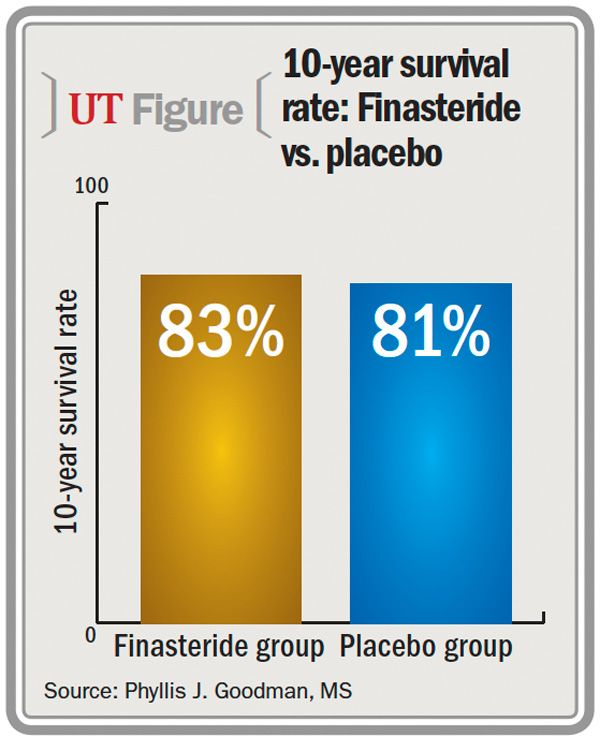Article
5-ARI does not affect prostate cancer mortality
Eighteen years of follow-up of the Prostate Cancer Prevention Trial (PCPT) suggests that 7 years of treatment with the 5-alpha-reductase inhibitor finasteride (Proscar) for prostate cancer prevention does not appear to affect mortality but does reduce the risk of a prostate cancer diagnosis.
Orlando, FL-Eighteen years of follow-up of the Prostate Cancer Prevention Trial (PCPT) suggests that 7 years of treatment with the 5-alpha-reductase inhibitor finasteride (Proscar) for prostate cancer prevention does not appear to affect mortality but does reduce the risk of a prostate cancer diagnosis.
These findings, based on men randomized to the PCPT, were reported at the Genitourinary Cancers Symposium in Orlando, FL.
Finasteride is the only method shown to be efficacious in the prevention of prostate cancer. In the PCPT, finasteride reduced the relative risk of prostate cancer by 24.8%. Of concern in that trial was an increased relative risk of 26.9% of developing high-grade disease. Subsequent analysis found that finasteride increased the detection of prostate cancer through improved sensitivity of PSA, biopsy, and digital rectal exam as well as improved sensitivity to PSA and digital rectal exam for high-grade disease.
“Despite these analyses, finasteride has been largely eliminated for prevention of prostate cancer,” explained Phyllis J. Goodman, MS, lead author of the present study.
Because finasteride has the potential to substantially reduce the incidence of prostate cancer, Goodman and colleagues conducted an analysis of survival in the two study arms of the PCPT to seek evidence of increased risk of death in men randomized to finasteride. An increased risk of death in this group would be a potential indicator of a “true” increased risk of high-grade prostate cancer with lethal potential, said Goodman, lead statistician at SWOG Statistical Center, Seattle, who worked on the study with Leslie G. Ford, MD, of the National Cancer Institute, and co-authors.

The authors used a Social Security Death Index search on all participants randomized to finasteride and placebo to ascertain date of death. A total of 5,128 deaths have been reported: 2,584 in men on finasteride and 2,544 in men in the placebo group. The 15-year survival rate for all randomized men in each arm is 78%. The hazard ratio (HR) for overall survival on finasteride versus placebo is 1.04, which is not significantly different. Ten-year survival from diagnosis for men with prostate cancer was slightly higher in the finasteride group: 83% versus 81% for placebo, but again this was not significantly different.
There was no evidence for poorer survival for men with high-grade prostate cancer randomized to finasteride, while those who were diagnosed with low-grade prostate cancer had superior survival (p=.01).
Reason for survival discrepancy unclear
Goodman suggested that the explanation for the phenomenon of superior survival in the low-grade prostate cancer group could be lead-time bias. However, the identical survival in both treatment arms in men with high-grade prostate cancer argues against a lead-time bias.
She offered another potential explanation: that men with low-grade prostate cancer in the placebo group included a greater number of men with undetected high-grade disease, while high-grade prostate cancer was more likely to be detected in those who received finasteride due to the improved sensitivity and performance of prostate biopsy.
“If finasteride truly affected the natural history of the cancer, then this should be reflected as a long-term reduction of survival in this group,” said Bruce J. Roth, MD, professor of medicine at Washington University in St. Louis, who moderated a press presentation on the study findings but was not involved with the study. “In this report, with follow-up of 19 years, 7 years of finasteride does not decrease overall mortality from prostate cancer despite the diagnosis of higher grade tumors, but significantly reduces the risk of a prostate cancer diagnosis.”
One of Goodman’s co-authors has served as a consultant/adviser to the Cancer Prevention Research Institute of Texas; has received honoraria from the American Society of Clinical Oncology and the AUA; and has received research funding from the National Cancer Institute and National Institutes of Health.UT



